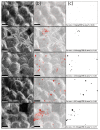Raman Microspectroscopic Analysis of Selenium Bioaccumulation by Green Alga Chlorella vulgaris
- PMID: 33920129
- PMCID: PMC8069876
- DOI: 10.3390/bios11040115
Raman Microspectroscopic Analysis of Selenium Bioaccumulation by Green Alga Chlorella vulgaris
Abstract
Selenium (Se) is an element with many commercial applications as well as an essential micronutrient. Dietary Se has antioxidant properties and it is known to play a role in cancer prevention. However, the general population often suffers from Se deficiency. Green algae, such as Chlorella vulgaris, cultivated in Se-enriched environment may be used as a food supplement to provide adequate levels of Se. We used Raman microspectroscopy (RS) for fast, reliable, and non-destructive measurement of Se concentration in living algal cells. We employed inductively coupled plasma-mass spectrometry as a reference method to RS and we found a substantial correlation between the Raman signal intensity at 252 cm-1 and total Se concentration in the studied cells. We used RS to assess the uptake of Se by living and inactivated algae and demonstrated the necessity of active cellular transport for Se accumulation. Additionally, we observed the intracellular Se being transformed into an insoluble elemental form, which we further supported by the energy-dispersive X-ray spectroscopy imaging.
Keywords: Chlorella vulgaris; EDX; ICP-MS; Raman spectroscopy; algae; bioaccumulation; selenium.
Conflict of interest statement
The authors declare no conflict of interest.
Figures







Similar articles
-
Removal of selenium containing algae by the bivalve Sinanodonta woodiana and the potential risk to human health.Environ Pollut. 2018 Nov;242(Pt A):73-81. doi: 10.1016/j.envpol.2018.06.074. Epub 2018 Jun 26. Environ Pollut. 2018. PMID: 29960927
-
Selenium accumulation in unicellular green alga Chlorella vulgaris and its effects on antioxidant enzymes and content of photosynthetic pigments.PLoS One. 2014 Nov 6;9(11):e112270. doi: 10.1371/journal.pone.0112270. eCollection 2014. PLoS One. 2014. PMID: 25375113 Free PMC article.
-
Release of reduced inorganic selenium species into waters by the green fresh water algae Chlorella vulgaris.Environ Sci Technol. 2011 Mar 15;45(6):2165-71. doi: 10.1021/es103337p. Epub 2011 Feb 22. Environ Sci Technol. 2011. PMID: 21341693
-
Selenium accumulation and metabolism in algae.Aquat Toxicol. 2017 Aug;189:1-8. doi: 10.1016/j.aquatox.2017.05.011. Epub 2017 May 25. Aquat Toxicol. 2017. PMID: 28554051 Review.
-
Ecotoxicology of selenium in freshwater systems.Rev Environ Contam Toxicol. 1994;134:31-48. doi: 10.1007/978-1-4684-7068-0_2. Rev Environ Contam Toxicol. 1994. PMID: 8290736 Review.
Cited by
-
Assessment of Biotechnologically Important Filamentous Fungal Biomass by Fourier Transform Raman Spectroscopy.Int J Mol Sci. 2021 Jun 23;22(13):6710. doi: 10.3390/ijms22136710. Int J Mol Sci. 2021. PMID: 34201486 Free PMC article.
References
-
- Gojkovic Ž., Garbayo I., Ariza J.L.G., Marova I., Vílchez C. Selenium bioaccumulation and toxicity in cultures of green microalgae. Algal Res. 2015;7:106–116. doi: 10.1016/j.algal.2014.12.008. - DOI
MeSH terms
Substances
Grants and funding
LinkOut - more resources
Full Text Sources
Other Literature Sources

